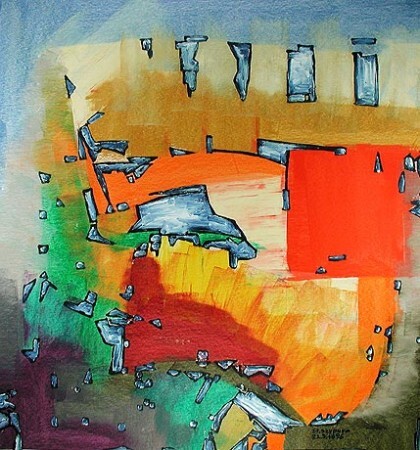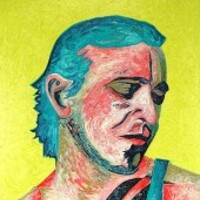Stanislaus Szypura (Stacho)
ABSTRAKTIONEN
m Zentrum des 2. Hauptthema „ABSTRAKTION“; steht die Polarität: Vorstellungskraft, Phantasie versus Intellektualität in Relation zur Kreativität. Das Forschen und Malen konzentriert sich hier auf die mentale Wirklichkeit des Menschen.
Geistige Realität stellt sich nicht nur im intellektuellen, im sachlichen, diskursiven, im konzentriert analytischen, kausalem und logisch wissenschaftlichen denken dar. Der menschliche Geist ist auch in Dimensionen der Phantasie, der Einbildung, des syntetischen, assoziativen, irrationalen und verrückten Denkens eine Tatsache. Neben der Synthese von Rationalität und Irrationalität, interessiert in diesem Erfahrungsfeld die Handhabung, die Navigation mentaler Wirklichkeiten; z.B. die Fähigkeit Bewußtsein hochkonzentriert in einem Punkt zu sammeln oder Bewußtsein wie ein Heizstrahler exzentrisch und radial auszustrahlen.
Der Begriff Topos wird etwas eigen in der Inhaltsangabe als geistiger oder seelischer Ort gebraucht. Als Mensch und Maler ist es wichtig, dass diese mentalen und psychischen Topoi nicht als virtuell oder hypothetisch gesehen werden. Diese Topoi sind so real, das seine Malerei durchaus als Dokumentation innerer Welten und seelischer Universen verstanden werden Kann.
Die Neugier kreist hauptsächlich um die Beziehung mentaler, psychischer Gegenstände (was immer das sein kann) und den ihnen umgebenden Raum. Die Kräfte dieser Beziehung und deren Interaktionen stehen im Fokus.
Die Polarität - Immaterialität versus Materialität - ist die Brücke zum Thema Kreativität.
Als Maler drängt die Frage: Wie wird aus Einbildung, aus gültiger geistiger und seelischer Realität ein seelenvolles und geistreiches Bild?
Genau dieses Phänomen der Materialisierung des Immateriellen ist ein weiteres Hauptthema der Werkgruppe „ABSTRAKTION“
The center of the 2nd main topic “ABSTRACTION”; is polarity: Imagination, fantasy versus intellectuality in relation to creativity.
Research and painting are concentrated here on mental reality of the human being.
Mental reality does not turn out to be only in intellectual, realistic, discursive, focused on analytic, causal and logical scientific thinkings. Human mind is a also fact in dimensions of fantasy, imagination of synthetic, associative, irrational and crazy thinkings. What interests people most of all in this field of experience is, apart from the synthesis of rationality and irrationality, the handling and the navigation of mental truths. E.g. the ability to pool consciousness highly focused in one spot or to radiate consciousness eccentrically and radially just like a heater.
The term “topos” is used in the summary as mental or spiritual place. For him as a human being and a painter it is important not to see these mental and psychical Topoi as virtual or hypothetical. These Topoi are so real, that their painting can be understood to be a documentation of internal worlds and spiritual universes.
Curiosity mainly pays attention to relation between mental, psychical matters (whichever it can be) and space, that encircles them. Powers of this relation and its interactions take the center stage.
Polarity- Immateriality versus materiality – paves the way to creativity.
For him as a painter it was an urging question how to change imagination and valid, mental and emotional reality into a soulful picture.
This phenomenon of materialization of the immaterial is a further main topic of „ABSTRACTION“.
Au centre du second thème principal, l’abstraction, il y a la polarité imagination-intellectualité, en relation avec la créativité. Ici, la recherche et la peinture se concentrent sur la réalité de l’esprit humain.
La réalité de l’esprit humain se manifeste non seulement dans la pensée factuelle, discursive, analytique concentrée, causale et scientifique-logique. L’esprit humain est aussi un fait tangible par les dimensions de l’imaginaire, de l’imagination, de la pensée synthétique, associative, irrationnelle et folle. Dans ce champ empirique, à côté de la synthèse entre rationalité et irrationalité, l’intérêt porte aussi sur le maniement, la navigation au sein de réalités psychiques ; par exemple sur la capacité à concentrer fortement la conscience en un seul point ou à la diffuser comme la chaleur d’un radiateur, de façon décentrée et radiale.
Le concept du « lieu » est utilisé de manière assez singulière dans la description du contenu, en tant que lieu de l’esprit ou de l’âme. Pour l’être humain et le peintre, il est important que ces lieux mentaux et psychiques ne soient pas considérés comme virtuels ou hypothétiques. Ces lieux sont si réels que sa peinture peut être indubitablement conçue comme une documentation de mondes intérieurs et d’univers de l’âme.
La curiosité tourne principalement autour de la relation entre des objets mentaux ou psychiques (peu importe ce dont il s’agit) et l’espace environnant. L’accent y est mis sur les forces et les interactions de cette relation.
La polarité immatérialité-matérialité est le pont qui mène à la créativité.
Une question s’impose alors au peintre : comment transposer l’imaginaire, la réalité valide de l’esprit et de l’âme en un tableau plein d’âme et d’esprit ?
C’est justement ce phénomène de la matérialisation de l’immatériel qui constitue un autre thème principal des œuvres regroupées sous le terme « ABSTRACTION ».
W centrum drugiego głównego tematu „abstrakcja“ stoi polaryzacja: wyobraźnia i fantazja na przeciw umysłowości w relacji do kreatywności. Poszukiwanie i malowanie koncentruje się tutaj na mentalnej rzeczywistości ludzkości.
Mentalna rzeczywistość uosabnia się nie tylko w intelektualnym, rzeczowym, dyskursywnym, analitycznie skoncentrowanym, przyczynowym i logicznym naukowym myśleniu.
Duch ludzki jest też faktem w wymiarach fantazji, urojenia, syntetycznego, asocjacyjnego, nieracjonalnego i zwariowanego myślenia. Oprócz syntezy racionalności i nieracionalności interesuje w tym polu doświadczeń posługiwanie/nawigacja mentalnej rzeczywistości; n.p. zdolność koncentracji świadomośći w jednym punkcie, lub promieniowania świadomośći ekscentrycznie i radialnie jak grzejnik.
Pojęcie formatu „topos” jest używane w streszczeniu z lekką specyfiką duchowego miejsca.
Jako człowiek i malarz jest mu ważne że te mentalne i psychiczne formaty nie będą widziane jako wirtualne lub hiptetyczne. Te formaty są tak realne, że można zrozumieć jego malarstwo jako dokumentację światów wewnętrznych i duchowych wszechświatów.
Zaciekawienie krąży głównie wokół związku mentalnych, psychicznych objektów (co kolwiek to może być), i jemu przypisanej strefy. Siły tego związku i ich wzajemne oddziaływanie stoją w fokusie.
Polaryzacja-niematerjalność przeciw materialności- jest pomostem do tematu kreatywności.
Jako malarz nasuwało mu się pytanie: Jak ztworzyć w wyobraźni, z duchowej rzeczywistości obraz błyskotliwy i pełen ducha?
Dokładnie ten fenomen materializacji niematerialności jest dalszym głównym tematem jego dzieł „abstrakcja”.
2つ目の主題である「抽象」の中心になっているのは、対極性である。想像力に関係する空想・想像力―知力。この追究と描写が集中してなされるのは、人間の精神活動の現実である。
精神活動の現実は、知的で事実に即し、推論的、集中分析的、因果な、論理的表現をする。幻想や想像、合成、連想的、非合理的で尋常でない思考の次元であっても、人間の精神活動は事実である。合理と非合理性の総合以外にも、この場合、例えばある一点に意識集中したり、放射電熱器のようにエキセントリックにかつ放射状に意識を発することができる能力のような精神活動実現とそのナビゲーションが興味深いのだ。
トポスという言葉が内容説明のところで精神や魂の宿る場所としてふさわしく用いられている。人または画家として、この精神、心のトポスが潜在的または仮のものにされない事が重要である。このトポスは非常に現実的であるので、彼の絵画は人間の内側の世界と精神宇宙のドキュメンタリーとして解釈することができる。
好奇心は、心や精神の対象物(常にそれになりえる物)の関係とそれを取り巻く空間の周りを循環している。この関係とその相互作用に働く力が焦点になっている。
非物質性―物質性の対極は、「想像性」というテーマにかかっている。
いかにして想像、的確な精神・情緒の現実から魂の入った才気あふれる作品を生み出す事ができるのか、画家としてこのような疑問が頭の中を渦巻いている。
非物質の物質化、まさにこの現象が、作品グループ「抽象」のさらなる主題となっている。
第二個主題“抽象”的中心是對立性:与獨創性有關的想象力、幻想相對理智。研究和繪畫集中与人的思想真實性。
精神的真實性不止是描述理智的、實事求是的、推理的、全神貫注分析的、邏輯因果的科學思考。人的思想在想象、幻覺、綜合、聯想的、非理性和古怪的維度里是一個事實。除了理性和非理性的組合,在這個經驗領域里思想的真實性的運用和導航作用也是令人感興趣的。比如高度集中于某一點的知覺能力或者知覺象一個輻射器那樣偏离,徑向地擴散。
Topo(地形)定義特別是在內容上作為精神或心靈的地方。作為一個人和身為畫家重要的是,這种思想和心理的Topoi(地形)不能被看作是潛在的或假定的。
這些Topoi(地形)是這么的真實,以致他的繪畫絕對是作為內心世界和心靈世界的記錄來理解。
他的好奇心總是集中在對象的思想、心理的相互關系方面(可能總是這樣)以及圍繞他們的空間。這种關系和他們相互活動的力量是重點。
對立性-非物質性對物質性-是通往創造性主題的橋梁。
作為畫家迫切需要解決的問題是:如何從幻覺、有效的精神和心靈真實性轉變成一幅富有感情和有見解的畫呢?
這非物質性的物質化現象將是作品集“抽象”里的另一個主題。
第二个主题“抽象”的中心是对立性:与独创性有关的想象力、幻想相对理智。研究和绘画集中与人的思想真实性。
精神的真实性不止是描述理智的、实事求是的、推理的、全神贯注分析的、逻辑因果的科学思考。人的思想在想象、幻觉、综合、联想的、非理性和古怪的维度里是一个事实。除了理性和非理性的组合,在这个经验领域里思想的真实性的运用和导航作用也是令人感兴趣的。比如高度集中于某一点的知觉能力或者知觉象一个辐射器那样偏离,径向地扩散。
Topo(地形)定义特别是在内容上作为精神或心灵的地方。作为一个人和身为画家重要的是,这种思想和心理的Topoi(地形)不能被看作是潜在的或假定的。
这些Topoi(地形)是这么的真实,以致他的绘画绝对是作为内心世界和心灵世界的记录来理解。
他的好奇心总是集中在对象的思想、心理的相互关系方面(可能总是这样)以及围绕他们的空间。这种关系和他们相互活动的力量是重点。
对立性-非物质性对物质性-是通往创造性主题的桥梁。
作为画家迫切需要解决的问题是:如何从幻觉、有效的精神和心灵真实性转变成一幅富有感情和有见解的画呢?
这非物质性的物质化现象将是作品集“抽象”里的另一个主题。


